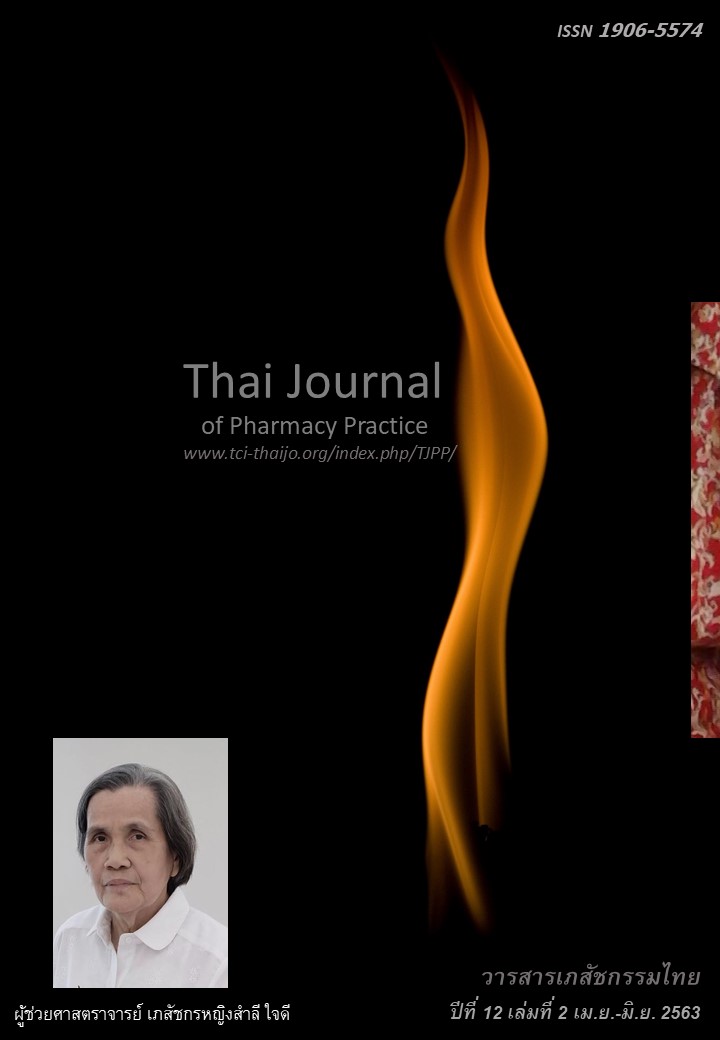Prevalence and Pattern of Complementary Use of Biologically Based Therapy among Patients with Type 2 Diabetes In Khumkeankaew District’s Contracting Unit for Primary Care, Yasothon
Main Article Content
Abstract
Objective: To study the prevalence and types of complementary medicines by biologically based therapy (CMBBT) used by patients with type 2 diabetes registered and receiving treatment from Khumkeankaew District’s Contracting Unit for Primary Care, Yasothon. Method: This research was a cross-sectional survey in 350 randomly sampled subjects. Data collection was conducted by interviewing the subjects with structured questionnaires during October - December 2017 on the use of CMBBT. Results: 51.7% of the respondents did not agree that the CMBBT was effective. Ninety-one subjects (26.0%) had used CMBBT together with prescribed medications within 3 months before the interview. The prevalence of CMBBT usage in the past year of the subjects was 34.9%. The most commonly used CMBBT was herbs (57 herbs) including pandan, Ganoderma lucidum, Yanang, followed by dietary supplements (25 products) including red algae, ginseng coffee, rice bran products. Conclusion: Majority of the CMBBT use in patients with type 2 diabetes in Khumkeankaew District’s Contracting Unit for Primary Care, Yasothon was herbs. The research results are useful in planning patient education, and surveillance of adverse reactions from the use of CMBBT together with the use of prescribed medications for pharmacists, relevant medical personnel and patients.
Article Details
ผลการวิจัยและความคิดเห็นที่ปรากฏในบทความถือเป็นความคิดเห็นและอยู่ในความรับผิดชอบของผู้นิพนธ์ มิใช่ความเห็นหรือความรับผิดชอบของกองบรรณาธิการ หรือคณะเภสัชศาสตร์ มหาวิทยาลัยสงขลานครินทร์ ทั้งนี้ไม่รวมความผิดพลาดอันเกิดจากการพิมพ์ บทความที่ได้รับการเผยแพร่โดยวารสารเภสัชกรรมไทยถือเป็นสิทธิ์ของวารสารฯ
References
2. Internatioanl Diabetes Federation. Diabetes Atlas 8th ed [online] 2017 [cited Aug 27, 2018] Available from: www.idf.org/e-library/.../134-idf-diabetes-atlas-8th-edition.html.
3. Chang HY, Wallis M, Tiralongo E, Wang HL. Decision-making related to complementary and alternative medicine use by people with Type 2 diabetes: a qualitative study. J Clin Nurs. 2012; 21:3205-15.
4. The Association of Diabetes Mellitus of Thailand. The practice guidelines of diabetes mellitus 2017. Patumtani: Romyen Media; 2017.
5. Sornsuvit C, Phosuya C, Jaroonwanichkul D, Piriyachananusorn N. The use of herbal and dietary supplements and potential interactions with drugs in patients with chronic disease. Thai Pharmaceu tical and Health Science Journal 2012; 7: 149-54.
6. Division of Complementary and Alternative Medicine, Department for Development of Thai Traditional and Alternative Medicine. The World Health Organization’s suggestion on the preparation of appropriate information for consumers in traditional medicine, complementary medicine and alternative medicine. Bangkok: National Office of Buddhism Publishing House; 2007.
7. MacLennan AH, Wilson DH, Taylor AW. The escalating cost and prevalence of alternative medicine. Prev Med 2002; 35: 166-73.
8. Armstrong AR, Thiébaut SP, Brown LJ, Nepal B. Australian adults use complementary and alterna- tive medicine in the treatment of chronic illness: a national study. Aust N Z J Public Health. 2011; 35: 384-90. doi: 10.1111/j.1753-6405.2011.00745.x.
9. Esmonde L, Long AF. Complementary therapy use by persons with multiple sclerosis: benefits and research priorities. Complement Ther Clin Pract. 2008; 14:176-84.
10. Bishop FL, Lewith GT. Who uses CAM? A narrative review of demographic characteristics and health factors associated with CAM use. Evid Based Com plement Alternat Med. 2010; 7: 11-28.
11. Eisenberg DM, Kessler RC, Foster C, Norlock FE, Calkins DR, Delbanco TL. Unconventional medicine in the United States. Prevalence, costs, and patterns of use. N Engl J Med. 1993; 328: 246-52.
12. Kengkanpanich T, Leerapan P, Kengkanpanich M, Nunthasen K, Lattanand K. Factors related to herbal consumption for controlling blood sugar of patients with type 2 diabetest mellitus. Journal of Boromarajonani College of Nursing, Bangkok 2015; 31: 13-25.
13.Pimpa R, Manirat T, Imamee N, Tansakun S. Herbal using behaviors among diabetes, Kanchanaburi Province. Journal of Boromarajonani College of Nursing, Bangkok 2014; 30: 14-25.
14. Kumkaenkao Hospital. Report on patient care team on 2018. Yasothon: Kumkaenkao Hospital; 2018.
15. Sawatsri P. The use of herbs and indigenous food crop behaviors for blood sugar reduction among type 2 diabetic patients at subdistrict health promoting
hospital, Ongkharak Hospital Network, Nakhonnayok Province. Journal of Phrapokklao Nursing College 2015; 26: 35-47.
16. Venkataramanan S. The study of hepatotoxicity effect of Momordica charantia on rat’s liver. Anal Biochem 2016; 5(3Suppl): 20.
17. Yang HN, Kim DJ, Kim YM, Kim BH, Sohn KM, Choi MJ,et al. Aloe-induced toxic hepatitis.J Korean Med Sci 2010;25:492-5.
18. Tangkiatkumjai M. Existing evidence for safe use of herbal medicines in chronic kidney disease. Int J Pharm Pharm Sci 2015; 7:30-4.
19. Melis MS. Chronic administration of aqueous extract of Stevia rebaudiana in rats: renal effects. J Ethnopharmacol 1995; 47: 129-34.
20. Atangwho IJ, Yin KB, Umar MI, Ahmad M, Asmawi MZ. Vernonia amygdalina simultaneously suppresses gluconeogenesis and potentiates glucose oxidation via the pentose phosphate pathway in streptozotocin-induced diabetic rats. BMC Complement Altern Med. 2014;14: 426. doi: 10.1186/1472-6882-14-426.
21.Tangkiatkumjai M, Boardman H, Praditpornsilpa K. Association of herbal and dietary supplements with progression and complications of chronic kidney disease: A prospective cohort study. Nephrology 2015; 20:679-87.


